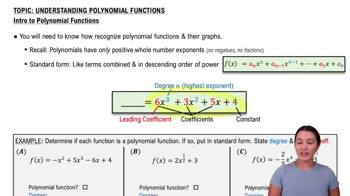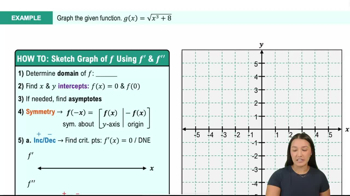Table of contents
- 0. Functions7h 52m
- Introduction to Functions16m
- Piecewise Functions10m
- Properties of Functions9m
- Common Functions1h 8m
- Transformations5m
- Combining Functions27m
- Exponent rules32m
- Exponential Functions28m
- Logarithmic Functions24m
- Properties of Logarithms34m
- Exponential & Logarithmic Equations35m
- Introduction to Trigonometric Functions38m
- Graphs of Trigonometric Functions44m
- Trigonometric Identities47m
- Inverse Trigonometric Functions48m
- 1. Limits and Continuity2h 2m
- 2. Intro to Derivatives1h 33m
- 3. Techniques of Differentiation3h 18m
- 4. Applications of Derivatives2h 38m
- 5. Graphical Applications of Derivatives6h 2m
- 6. Derivatives of Inverse, Exponential, & Logarithmic Functions2h 37m
- 7. Antiderivatives & Indefinite Integrals1h 26m
- 8. Definite Integrals4h 44m
- 9. Graphical Applications of Integrals2h 27m
- 10. Physics Applications of Integrals 2h 22m
5. Graphical Applications of Derivatives
Curve Sketching
Problem 4.4.13g
Textbook Question
Let ƒ(x) = (x - 3) (x + 3)²
g. Use your work in parts (a) through (f) to sketch a graph of ƒ.
 Verified step by step guidance
Verified step by step guidance1
Step 1: Begin by expanding the expression (x + 3)². This will help simplify the function ƒ(x). The expansion of (x + 3)² is (x + 3)(x + 3) = x² + 6x + 9.
Step 2: Substitute the expanded form back into the function ƒ(x). The function now becomes ƒ(x) = (x - 3)(x² + 6x + 9)g.
Step 3: Distribute (x - 3) across the expanded polynomial (x² + 6x + 9). This involves multiplying each term in the polynomial by (x - 3), resulting in x³ + 6x² + 9x - 3x² - 18x - 27.
Step 4: Combine like terms from the distribution to simplify the expression further. The simplified form of the function is ƒ(x) = x³ + 3x² - 9x - 27.
Step 5: Analyze the behavior of the function ƒ(x) = x³ + 3x² - 9x - 27. Consider the critical points, inflection points, and intercepts to sketch the graph. Determine where the function is increasing or decreasing, and identify any local maxima or minima.
 Verified video answer for a similar problem:
Verified video answer for a similar problem:This video solution was recommended by our tutors as helpful for the problem above
Video duration:
14mPlay a video:
Was this helpful?
Key Concepts
Here are the essential concepts you must grasp in order to answer the question correctly.
Factoring Polynomials
Factoring polynomials involves expressing a polynomial as a product of its simpler components, or factors. In the given function ƒ(x) = (x - 3)(x + 3)², recognizing the factors helps identify the roots of the polynomial, which are the x-values where the function equals zero. This is crucial for sketching the graph, as the roots indicate where the graph intersects the x-axis.
Recommended video:

Introduction to Polynomial Functions
Multiplicity of Roots
The multiplicity of a root refers to the number of times a particular root appears in the factored form of a polynomial. In ƒ(x), the root x = -3 has a multiplicity of 2, meaning the graph will touch the x-axis at this point but not cross it. Understanding multiplicity is essential for accurately sketching the behavior of the graph near its roots.
Recommended video:

Derivatives of Inverse Sine & Inverse Cosine Example 1
End Behavior of Polynomials
The end behavior of a polynomial describes how the graph behaves as x approaches positive or negative infinity. For the polynomial ƒ(x) = (x - 3)(x + 3)², the leading term determines this behavior. Since the highest degree term is x^3, the graph will rise to positive infinity as x approaches both positive and negative infinity, which is important for sketching the overall shape of the graph.
Recommended video:

Introduction to Polynomial Functions

 11:41m
11:41mWatch next
Master Summary of Curve Sketching with a bite sized video explanation from Callie
Start learning




